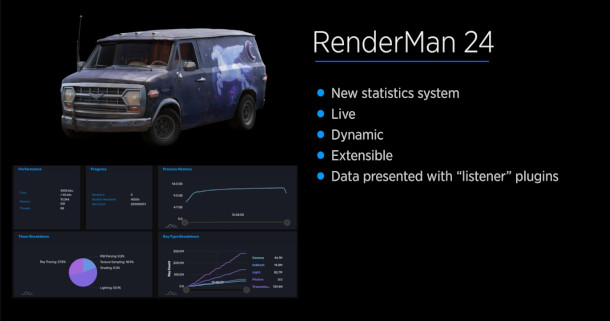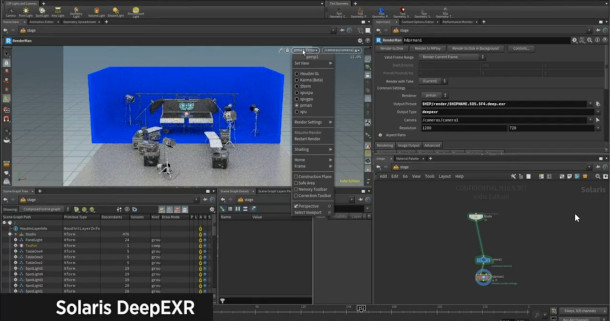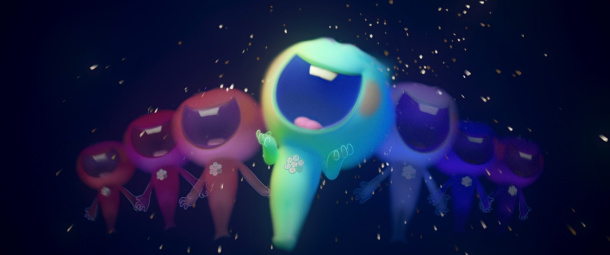Pixar releases RenderMan 24 with RenderMan XPU
Originally posted on 3 September 2020. We have updated the story with extra information from the release notes. Scroll down to the end for details of features announced since the original preview.
Pixar has unveiled RenderMan 24, the next major update to the VFX and animation production renderer, during livestreams at this week’s RenderMan Art & Science Fair.
The release, which is due to ship early next year, will include several important new toolsets, including a new sylised rendering system, and Lama, a new layered material system developed at ILM.
Pixar has also confirmed that RenderMan XPU, its long-awaited new combined CPU and GPU rendering system, will form part of the release, as will a new official integration plugin for Blender.
Stylized Looks generate anything from toon shading to brush stroke effects
Beginning with the feature that has been most widely previewed already, RenderMan 24 will support Stylized Looks, a new toolset for generating non-photorealistic renders.
It is capable of effects ranging from conventional cartoon shading to hatching or brush strokes, with the hatching reacting to emulated light effects, and supports custom AOVs and display filters.
Pixar describes it as “super-customisable”, noting that work “usually done in comp” to stylise an image can now be performed directly during rendering.
However, the toolset will only be available to users of the commercial edition of the software: something Pixar attributed to the work being a partnership with third-party developer LollipopShaders.
Lama: a robust new modular system for layered materials developed at ILM
RenderMan 24 will also feature Lama, a new layered materials system developed at Industrial Light & Magic, and and an “official part” of the ILM-developed MaterialX standard.
Pixar described it as a “much more robust layering system” than the existing PxrLayerSurface material, avoiding the need to use a single material with a “ton of parameters”.
Instead, Lama enables shading TDs to build up layered materials via a modular workflow, wiring together a series of BxDF (Bidirectional Distribution Function) nodes developed by ILM.
They include BxDFs for dielectric and conductor materials, and a Lama version of the old PxrDisney shader with support for subsurface scattering.
Other key features include LamaHairChiang, a layerable version of the Pixar Chiang hair shader used in production at Pixar, and support for dispersion: a common request among RenderMan users.
Users can write their own custom nodes, but Pixar says that even out of the box, Lama can replicate most of the existing “monolithic” BxDFs included in the software.
In addition, the Preset Browser has been updated to save Lama materials and display filters, making it possible to share them between RenderMan-compatible DCC applications.
New Phasor Noise, Hex Tiling and Bump Mixer patterns
RenderMan’s existing library of procedurally generated material Patterns has been rewritten to fully support OSL (Open Shading Language).
Execution is accelerated on both Intel and AMD CPUs vai the SIMD AVX-512 extensions.
New patterns available included Phasor Noise, developed at ILM during production on Star Wars: The Rise of Skywalker, and Hex Tiling, intended to blend tiled textures seamlessly.
There is also a new Bump Mixer, which replaces the old bump map handling system, and is described by ILM as meaning that users “don’t have to execute bump code three times”.
In addition, a new Bump Roughness system helps to preserve micro-details of surfaces, traditionaly lost in medium and wide shots, when the surface is some distance from the render camera.

New live statistics system for TDs, support for blue noise sampling
TDs get a user-customisable new Live Statistics system, which displays memory usage, rays traced and other key metrics in real time during render sessions.
Other changes include support for blue noise sampling for interactive renders.
The feature, also rencently introduced V-Ray 5, results in more even noise distribution in renders with small numbers of samples, generating a usable preview image more quickly.
Support for ACES and VFX Reference Platform CY2019
For pipeline integration, RenderMan 24 supports the CY2019 spec for the VFX Reference Platform, plus OpenColorIO 1.1 from the 2020 spec.
The release also adds “basic support” for the new ACEScg colour space from the industry-standard ACES colour encoding system. The implementation supports lights, patterns, textures and the ‘it’ render window.
New CPU/GPU rendering system RenderMan XPU will ship with version 24
RenderMan 24 will also ship with RenderMan XPU, Pixar’s long-awaited heterogeneous rendering system.
First announced in 2017, XPU is intended to enable RenderMan to generate renders interchangeably on CPU, GPU or both CPU and GPU together.
In Pixar’s demos, XPU renders were up to 10x faster than existing RIS renders on one of the studio’s standard artist workstations with a 24-core Intel Xeon Platinum 8268 CPU and Nvidia Quadro RTX 6000 GPU.
However, the speed boost depends heavily on the geometric and shading complexity of the scene, and whether you are rendering using CPU, GPU or both.
To use it, you will need to be working on Windows or Linux: XPU requires at least a Nvidia Maxwell GPU, so it won’t support the AMD GPUs in current Macs, and initially, Pixar isn’t supporting Apple Silicon CPUs.
The initial release is focused on interactive rendering for look development work, although Pixar says that XPU is ultimately intended to replace RenderMan’s existing RIS architecture for final-frame rendering.
Key features not currently supported include NURBS and “exotic” geometry types like blobby surfaces, light linking, volumetrics, point clouds, AOVs and Light Path Expressions and deep output.
XPU also does not currently support some of the other new features from RenderMan 24, including Lama. You can find more details in Pixar’s online FAQs, and a detailed feature support table here.

Integration plugins for Maya, Houdini, Katana, Mari – and now Blender
The Maya, Houdini and Katana integration plugins all get the features from core renderer, with RenderMan for Houdini 24 also extending support for Houdini’s new Solaris look development toolset.
New features due to be supported within Solaris include DeepEXR output and the Preset browser. Users will also be able to edit or switch between AOVs during render sessions.
RenderMan for Maya 24 features “initial support” for Maya 2022, with support for new Maya 2022 features – including its new USD workflows – to follow.
The release will also bring an entirely new integration: an official Blender plugin, which replaces the unofficial – and not recently updated – version. Find full details of RenderMan for Blender here.

A still from Pixar’s Soul, used as a marketing image for RenderMan 24.
Updated 30 June 2021: Pixar has released RenderMan 24.
As well as the new features listed above, the release updates RenderMan’s existing RIS render architecture, including new single scattering options in PxrSurface, and a PxrRadialDensity pattern for volume falloffs.
You can find a list of known differences in rendered output between RIS 24 and RIS 23 in the online release notes. Pixar describes them as “minor look differences”.
Pricing and availability
RenderMan 24 is available for Windows 10, CentOS/RHEL 7.2+ Linux and macOS 10.13+. The integration plugins are compatible with Blender 2.83/2.92, Houdini 17.5+, Katana 3.1 and Maya 2019+, plus Mari 4.5+.
New node-locked or floating licences cost $595. There is also a free non-commercial edition of RenderMan, which has also been updated to version 24.
Read an overview of the new features in RenderMan 24 on the product website
Read a full list of new features in RenderMan 24 in the online release notes
Download the free non-commercial version of RenderMan (Registration required)
